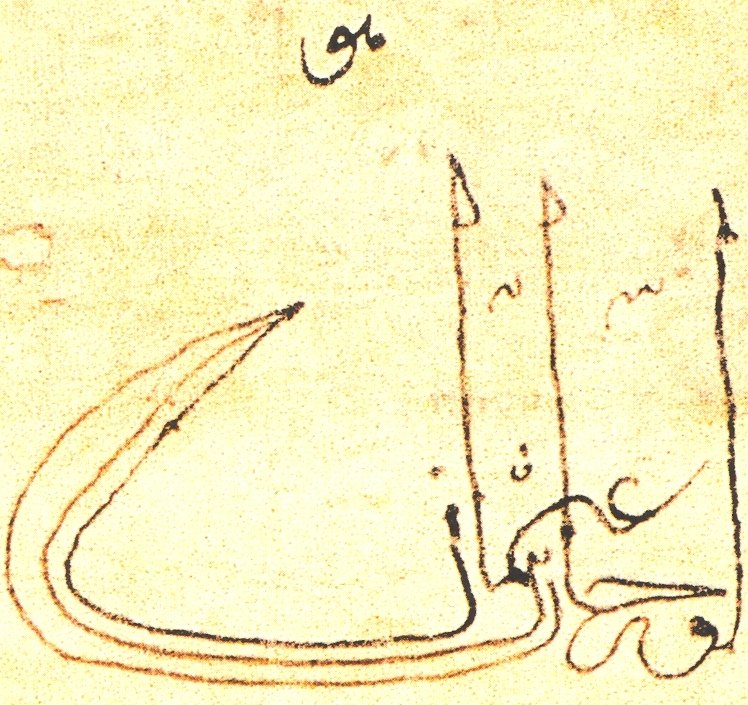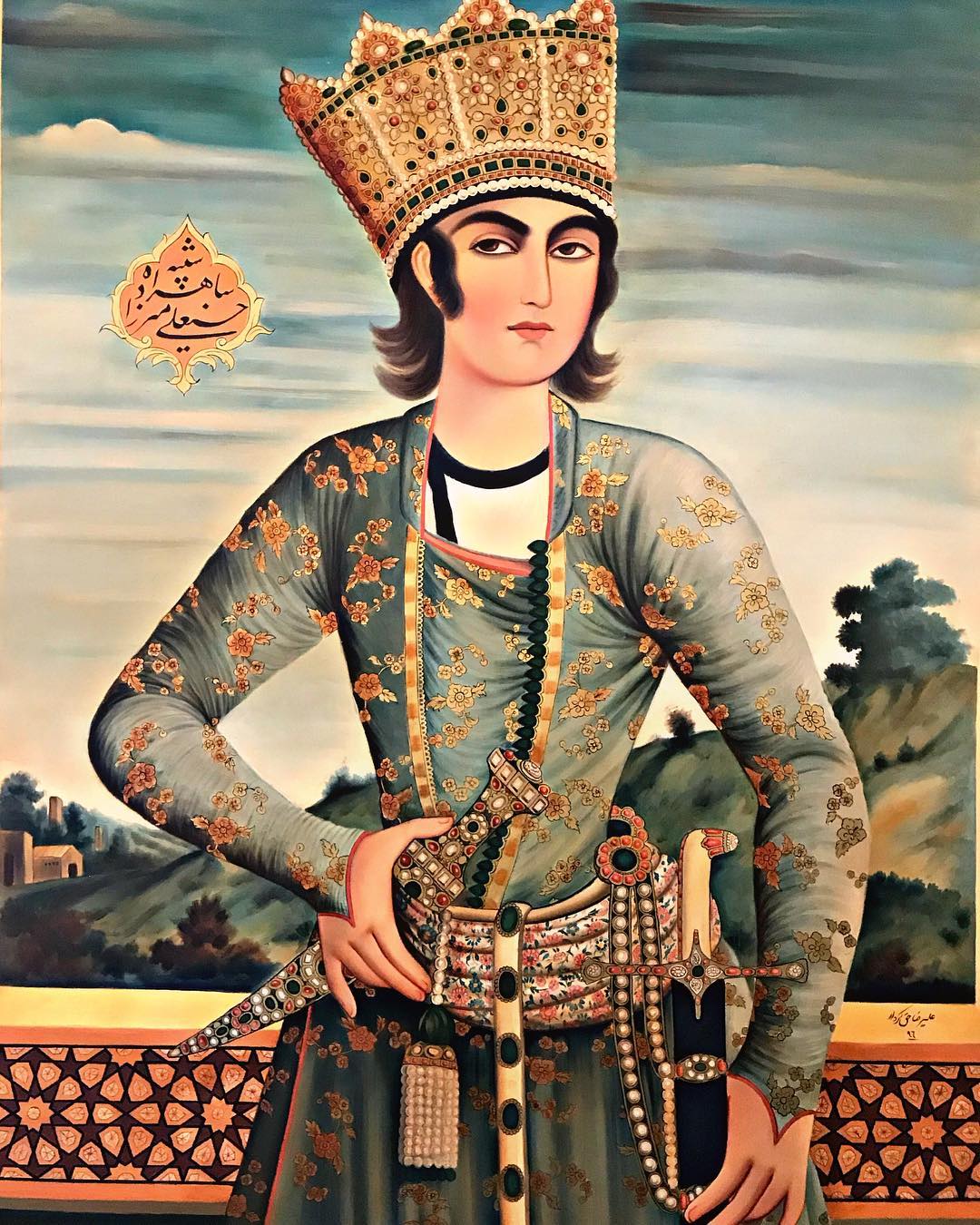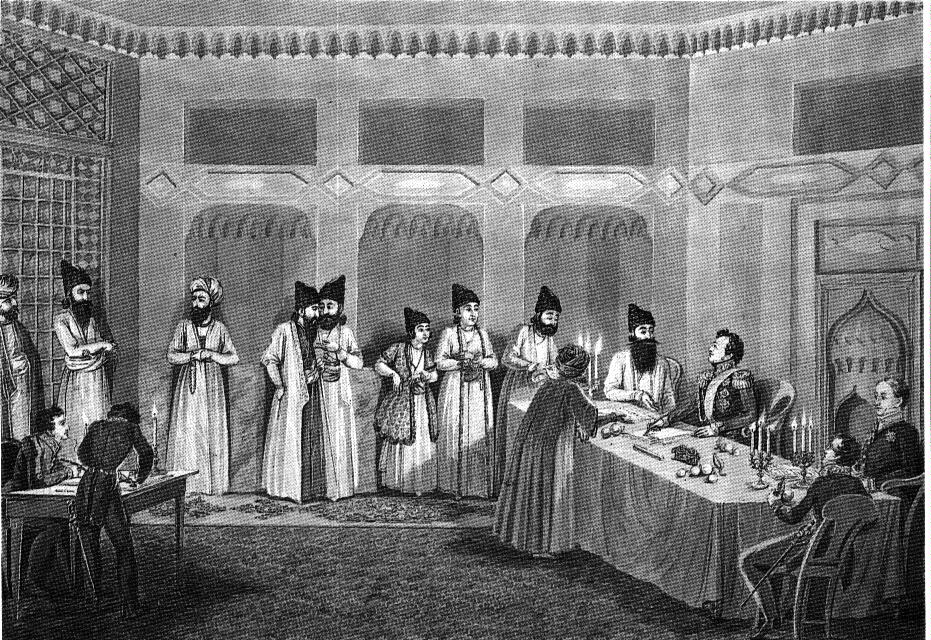|
Fath Ali Shah Qajar
Fath-Ali Shah Qajar ( fa, فتحعلىشاه قاجار, Fatḥ-ʻAli Šâh Qâjâr; May 1769 – 24 October 1834) was the second Shah (king) of Qajar Iran. He reigned from 17 June 1797 until his death on 24 October 1834. His reign saw the irrevocable ceding of Iran's northern territories in the Caucasus, comprising what is nowadays Georgia, Dagestan, Azerbaijan, and Armenia, to the Russian Empire following the Russo-Persian Wars of 1804–1813 and 1826–1828 and the resulting treaties of Gulistan and Turkmenchay. Historian Joseph M. Upton says that he "is famous among Iranians for three things: his exceptionally long beard, his wasp-like waist, and his progeny." At the end of his reign, his difficult economic problems and military and technological liabilities took Iran to the verge of governmental disintegration, which was quickened by a consequent struggle for the throne after his death. Under Fath-Ali Shah, many visual portrayals of himself and his court were created i ... [...More Info...] [...Related Items...] OR: [Wikipedia] [Google] [Baidu] |
Shahanshah
Shah (; fa, شاه, , ) is a royal title that was historically used by the leading figures of Iranian monarchies.Yarshater, EhsaPersia or Iran, Persian or Farsi, ''Iranian Studies'', vol. XXII no. 1 (1989) It was also used by a variety of Persianate societies, such as the Ottoman Empire, the Kazakh Khanate, the Khanate of Bukhara, the Emirate of Bukhara, the Mughal Empire, the Bengal Sultanate, historical Afghan dynasties, and among Gurkhas. Rather than regarding himself as simply a king of the concurrent dynasty (i.e. European-style monarchies), each Iranian ruler regarded himself as the Shahanshah ( fa, شاهنشاه, translit=Šâhanšâh, label=none, ) or Padishah ( fa, پادشاه, translit=Pâdešâh, label=none, ) in the sense of a continuation of the original Persian Empire. Etymology The word descends from Old Persian ''xšāyaθiya'' "king", which used to be considered a borrowing from Median, as it was compared to Avestan ''xšaθra-'', "power" and "command" ... [...More Info...] [...Related Items...] OR: [Wikipedia] [Google] [Baidu] |
Hossein Qoli Khan Qajar
Hossein Qoli Khan Qajar ( fa, حسین قلی خان قاجار) was the Qajar chieftain of the Qoyunlu branch from 1759 till his death in 1777. Biography Background He belonged to the Qoyunlu (also spelled Qawanlu) branch of the Qajar tribe. The tribe had several other branches, one of the most prominent ones being the Develu, which often fought against the Qoyunlu. Hossein Qoli Khan was one of the youngest sons of the chieftain of the Qoyunlu clan, Mohammad Hasan Khan Qajar, and the grandson of Fath Ali Khan, a prominent aristocrat executed by the orders of shah Tahmasp II (possibly at the urging of Nader Qoli Beg, who would become known as Nader Shah after usurping the throne of Iran in 1736, marking the foundation of the Afsharid dynasty). Hossein Qoli Khan had several half-brothers and full-brothers: Agha Mohammad Khan Qajar, Morteza Qoli Khan, Mostafa Qoli Khan, Reza Qoli Khan, Jafar Qoli Khan, Mahdi Qoli Khan, Abbas Qoli Khan Qajar and Ali Qoli Khan. When Nader Shah die ... [...More Info...] [...Related Items...] OR: [Wikipedia] [Google] [Baidu] |
Caucasus
The Caucasus () or Caucasia (), is a region between the Black Sea and the Caspian Sea, mainly comprising Armenia, Azerbaijan, Georgia, and parts of Southern Russia. The Caucasus Mountains, including the Greater Caucasus range, have historically been considered as a natural barrier between Eastern Europe and Western Asia. Mount Elbrus in Russia, Europe's highest mountain, is situated in the Western Caucasus. On the southern side, the Lesser Caucasus includes the Javakheti Plateau and the Armenian highlands, part of which is in Turkey. The Caucasus is divided into the North Caucasus and South Caucasus, although the Western Caucasus also exists as a distinct geographic space within the North Caucasus. The Greater Caucasus mountain range in the north is mostly shared by Russia and Georgia as well as the northernmost parts of Azerbaijan. The Lesser Caucasus mountain range in the south is occupied by several independent states, mostly by Armenia, Azerbaijan, and Georgia, but also ... [...More Info...] [...Related Items...] OR: [Wikipedia] [Google] [Baidu] |
Shah
Shah (; fa, شاه, , ) is a royal title that was historically used by the leading figures of Iranian monarchies.Yarshater, EhsaPersia or Iran, Persian or Farsi, ''Iranian Studies'', vol. XXII no. 1 (1989) It was also used by a variety of Persianate societies, such as the Ottoman Empire, the Kazakh Khanate, the Khanate of Bukhara, the Emirate of Bukhara, the Mughal Empire, the Bengal Sultanate, historical Afghan dynasties, and among Gurkhas. Rather than regarding himself as simply a king of the concurrent dynasty (i.e. European-style monarchies), each Iranian ruler regarded himself as the Shahanshah ( fa, شاهنشاه, translit=Šâhanšâh, label=none, ) or Padishah ( fa, پادشاه, translit=Pâdešâh, label=none, ) in the sense of a continuation of the original Persian Empire. Etymology The word descends from Old Persian ''xšāyaθiya'' "king", which used to be considered a borrowing from Median, as it was compared to Avestan ''xšaθra-'', "power" and " ... [...More Info...] [...Related Items...] OR: [Wikipedia] [Google] [Baidu] |
Tughra
A tughra ( ota, طغرا, ṭuġrā) is a calligraphic monogram, seal or signature of a sultan that was affixed to all official documents and correspondence. Inspired by the tamgha, it was also carved on his seal and stamped on the coins minted during his reign. Very elaborate decorated versions were created for important documents that were also works of art in the tradition of Ottoman illumination, such as the example of Suleiman the Magnificent in the gallery below. The tughra was designed at the beginning of the sultan's reign and drawn by the court calligrapher or '' nişancı'' on written documents. The first tughra examples are from the 14th century. Tughras served a purpose similar to the cartouche in ancient Egypt or the Royal Cypher of British monarchs. Every Ottoman sultan had his own individual tughra. Etymology There are two main schools of thought on the origins of the word tughra. The first sees it derived from a Turkic secretarial emblem called ''tughragh'', an ... [...More Info...] [...Related Items...] OR: [Wikipedia] [Google] [Baidu] |
Shia Islam
Shīʿa Islam or Shīʿīsm is the second-largest branch of Islam. It holds that the Islamic prophet Muhammad designated ʿAlī ibn Abī Ṭālib as his successor (''khalīfa'') and the Imam (spiritual and political leader) after him, most notably at the event of Ghadir Khumm, but was prevented from succeeding Muhammad as the leader of the Muslims as a result of the choice made by some of Muhammad's other companions (''ṣaḥāba'') at Saqifah. This view primarily contrasts with that of Sunnī Islam, whose adherents believe that Muhammad did not appoint a successor before his death and consider Abū Bakr, who was appointed caliph by a group of senior Muslims at Saqifah, to be the first rightful (''rāshidūn'') caliph after Muhammad. Adherents of Shīʿa Islam are called Shīʿa Muslims, Shīʿītes, or simply Shīʿa or Shia. Shīʿa Islam is based on a ''ḥadīth'' report concerning Muhammad's pronouncement at Ghadir Khumm.Esposito, John. "What Everyone Nee ... [...More Info...] [...Related Items...] OR: [Wikipedia] [Google] [Baidu] |
Hossein Ali Mirza
Hossein Ali Mirza (; 26 August 1789 – 16 January 1835), a son of Fath-Ali Shah (1797–1834), was the Governor of Fars and pretender to the throne of Qajar Iran. As governor, Ali Mirza restored Shah Cheragh. He opened the tombs of the Achaemenid kings to obtain gold, but found them empty. During his rule, the city of Shiraz was subjected to high taxation and low security. Ali Mirza gained independence from the government of Hajji Mohammad Hossein Isfahani, rented Bushehr ports to the British and stopped paying taxes after 1828, thus going 200,000 tomans in tax arrears to the crown. After Fath-Ali Shah's death, Prince Mohammad Mirza was crowned shah (king) as Mohammad Shah Qajar, but Ali Mirza formerly as the fifth in line for the throne, led a revolt and entitled himself as Hossein Ali Shah. After two months he was defeated in Shiraz by Manouchehr Khan Gorji. On the orders of Mohammad Shah, Ali Mirza was blinded and imprisoned in Ardabil, where he died of cholera in Janu ... [...More Info...] [...Related Items...] OR: [Wikipedia] [Google] [Baidu] |
Ziaʾ Al-Saltaneh
Zia ol-Saltaneh (1799–1873; Persian: ضیاء السلطنه), also known as Shah Begum Khanum, was a Persian calligrapher and poet. The seventh most senior daughter of the second Qajar ruler of Iran, Fath-ʿAli Shah, she served as private secretary to her father. The name usually used for her, Ziaʾ al-Saltaneh, meaning "Light of the Realm", was given to her by her father, and is an indication of his great love and respect for her. Family Zia ol-Saltaneh's mother was Maryam Khanom, 39th wife of Fath-ʿAli Shah. From a Jewish family from Mazandaran, she was first married to Agha Muhammad Khan, uncle of Fath-ʿAli Shah and first of the Qajar rulers. Zia ol-Saltaneh had four full brothers, Mahmud Mirza, Homayun Mirza, Ahmad-ʿAli Mirza, and Jahanshah Mirza, and one full sister, Sultan Begum. Later in life, she married Mirza Masʿud Garmrudi, then Minister of Foreign Affairs to Fath-ʿAli Shah's successor, Muhammad Shah. She was not raised by her own mother, but by the Shah's mo ... [...More Info...] [...Related Items...] OR: [Wikipedia] [Google] [Baidu] |
Abbas Mirza
Abbas Mirza ( fa, عباس میرزا; August 26, 1789October 25, 1833) was a Qajar crown prince of Iran. He developed a reputation as a military commander during the Russo-Persian War of 1804–1813 and the Russo-Persian War of 1826–1828, as well as through the Ottoman–Persian War of 1821–1823. He is furthermore noted as an early modernizer of Persia's armed forces and institutions, and for his death before his father, Fath Ali Shah. Abbas was an intelligent prince, possessed some literary taste, and is noteworthy on account of the comparative simplicity of his life. With Abbas Mirza as the military commander of the Persian forces, Iran lost all of its territories in the Caucasus comprising the South Caucasus and parts of the North Caucasus (Dagestan) to Russia in conformity with the 1813 Treaty of Gulistan and the 1828 Treaty of Turkmenchay, following the outcomes of the 1804–1813 and 1826–1828 wars. Biography Abbas Mirza was born on August 26, 1789 in Nava, Maz ... [...More Info...] [...Related Items...] OR: [Wikipedia] [Google] [Baidu] |
Dowlatshah
Mohammad Ali Mirza Dowlatshah (4 January 1789, in Nava – 22 November 1821, in Taq-e Gara) was a famous Iranian Prince of the Qajar dynasty. He is also the progenitor of the Dowlatshahi Family of Persia. He was born at Nava, in Mazandaran, a Caspian province in the north of Iran. He was the first son of Fath-Ali Shah, the second Qajar king of Persia, and Ziba Chehr Khanoum, a Georgian girl of the Tsikarashvili family. He was also the elder brother (by seven months) of Abbas Mirza. Dowlatshah was the governor of Fars at age 9, Qazvin and Gilan at age 11, Khuzestan and Lorestan at age 16, and Kermanshah at age 19. In the battles with Russia and Persia's archrival, the Ottoman Empire, he defeated the Ottomans in Baghdad and Basra, and crushed the Russians in Yerevan and Tbilisi. Dowlatshah developed and improved the city of Kermanshah and established the city of Dowlat-Abad which was renamed Malayer. Dowlatshah had 10 sons. His descendants live in various countries around the wo ... [...More Info...] [...Related Items...] OR: [Wikipedia] [Google] [Baidu] |
Maryam Khanom
Maryam Khanom Bani Isra'il () was the royal consort of shah Agha Mohammad Khan Qajar (r. 1789–1797) and then the thirty-ninth royal consort of shah Fath-Ali Shah Qajar (r. 1797–1834). She was from Māzandarān and of Jewish origin, and so is sometimes referred to as "Maryam Khanom ''Bani Isra'il''" ( ar, بني إسرائيل, link=no "sons - or children - of Israel") to distinguish her from Maryam Khanom Gorji, another consort of Fath-Ali. She was reported to have "no rival in beauty". When she was widowed the first time, Hossein Khan Sardar Hossein Qoli Khan Sardar Qajar ( fa, حسین قلی خان سردار قاجار), better simply known as Hossein Khan Sardar () (born ca. 1742 – died 1831) was an Iranian statesman in Qajar Iran, who was the last governor of the Erivan Khanate ..., the brother of the new shah wished to marry her, but the Fath-Ali instead married her himself, which caused a conflict between them. 1888 edition online at She had eleven children, am ... [...More Info...] [...Related Items...] OR: [Wikipedia] [Google] [Baidu] |
Badralensa Khanum
Badralensa Khanum (19th-century) was a consort of shah Fath-Ali Shah Qajar of Persia (r. 1797–1834).Amanat, Abbas (1997). Pivot of the Universe: Nasir Al-Din Shah Qajar and the Iranian Monarchy, 1831-1896. I.B.Tauris. ISBN 978-1845118280. She was a niece of Agha Mohammad Khan Qajar Agha Mohammad Khan Qajar ( fa, آقا محمد خان قاجار, translit=Âqâ Mohammad Xân-e Qâjâr; 14 March 1742 – 17 June 1797), also known by his regnal name of Agha Mohammad Shah (, ), was the founder of the Qajar dynasty of Iran, rul .... She was one of the most influential women of the Qajar harem during the reign of Fath-Ali Shah Qajar. She was known for her conflict with Asieh Khanam Dolo. References {{Reflist * 19th-century births 19th-century deaths 19th-century Iranian women Qajar royal consorts ... [...More Info...] [...Related Items...] OR: [Wikipedia] [Google] [Baidu] |






